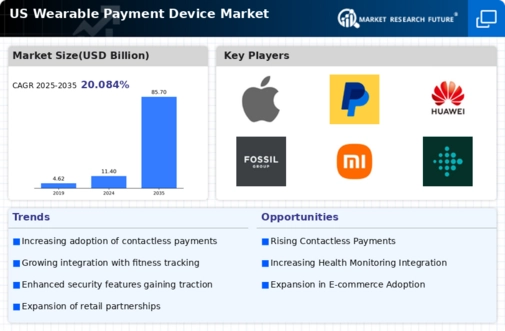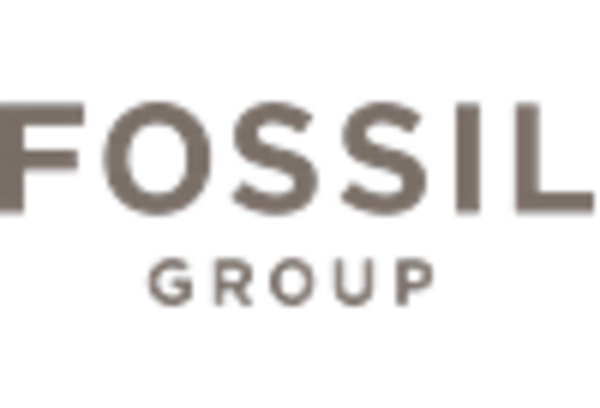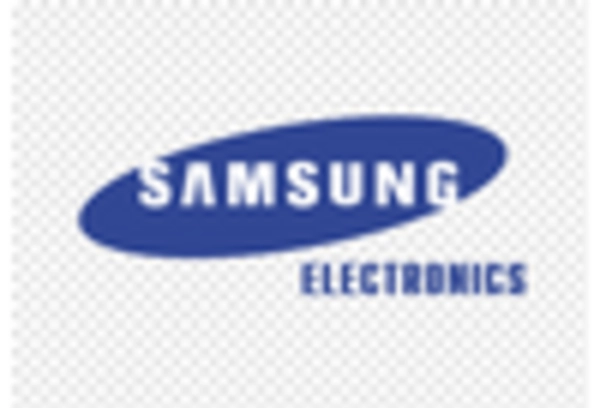Increased Focus on Health and Wellness
The wearable payment-device market is also being propelled by the heightened focus on health and wellness among consumers. Many wearable devices now incorporate health-tracking features, such as heart rate monitoring and fitness tracking, which appeal to health-conscious individuals. This integration of payment capabilities with health monitoring is creating a unique value proposition for consumers. As of 2025, the health and wellness market is estimated to reach $4 trillion, indicating a substantial opportunity for wearable payment devices that cater to this demographic. The convergence of health and finance in wearable technology suggests that consumers may increasingly seek devices that not only facilitate payments but also support their health goals, thereby expanding the market's potential.
Rising Demand for Enhanced Security Features
The wearable payment-device market is witnessing a rising demand for enhanced security features, which is crucial for consumer trust and adoption. As digital transactions become more prevalent, concerns regarding data security and privacy are paramount. Wearable devices that incorporate advanced security measures, such as biometric authentication and encryption, are likely to gain traction among consumers. Recent studies indicate that 80% of consumers prioritize security when choosing payment methods. This growing emphasis on security is prompting manufacturers to innovate and implement robust security protocols in their devices. Consequently, the wearable payment-device market is expected to benefit from this trend, as consumers seek solutions that not only offer convenience but also ensure the safety of their financial information.
Technological Advancements in Wearable Devices
The wearable payment-device market is experiencing rapid technological advancements, which are driving consumer adoption. Innovations in sensor technology, battery life, and connectivity options are enhancing the functionality of these devices. For instance, the integration of NFC (Near Field Communication) technology allows for seamless transactions, making it more convenient for users. As of 2025, the market is projected to grow at a CAGR of approximately 15%, indicating a robust demand for advanced wearable payment solutions. This growth is further fueled by the increasing penetration of smartphones and the Internet of Things (IoT), which are creating a more interconnected ecosystem. Consequently, consumers are more inclined to adopt wearable payment devices that offer enhanced features and improved user experiences.
Growing Consumer Preference for Contactless Payments
The shift towards contactless payment methods is significantly influencing the wearable payment-device market. As consumers increasingly prefer the convenience and speed of contactless transactions, wearable devices are becoming a preferred choice for payments. Recent surveys indicate that nearly 70% of consumers in the US express a preference for contactless payments over traditional methods. This trend is likely to continue, as more retailers and service providers adopt contactless payment systems. The wearable payment-device market is thus positioned to benefit from this consumer behavior, as it aligns with the demand for quick and efficient payment solutions. The convenience offered by wearables, combined with the growing acceptance of contactless technology, suggests a promising future for this segment.
Expansion of E-commerce and Digital Payment Solutions
The rapid expansion of e-commerce and digital payment solutions is a key driver for the wearable payment-device market. As online shopping continues to grow, consumers are seeking more efficient ways to make purchases. Wearable payment devices offer a convenient solution, allowing users to complete transactions quickly and securely. In 2025, e-commerce sales in the US are projected to surpass $1 trillion, highlighting the increasing reliance on digital payment methods. This trend is likely to encourage more consumers to adopt wearable payment devices, as they provide a seamless shopping experience. The integration of wearable technology with e-commerce platforms may further enhance the appeal of these devices, suggesting a strong correlation between the growth of online shopping and the adoption of wearable payment solutions.
















Leave a Comment